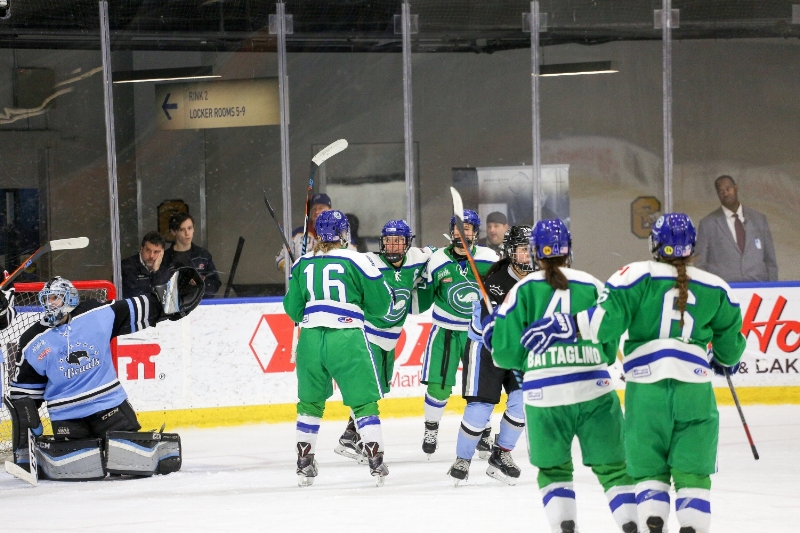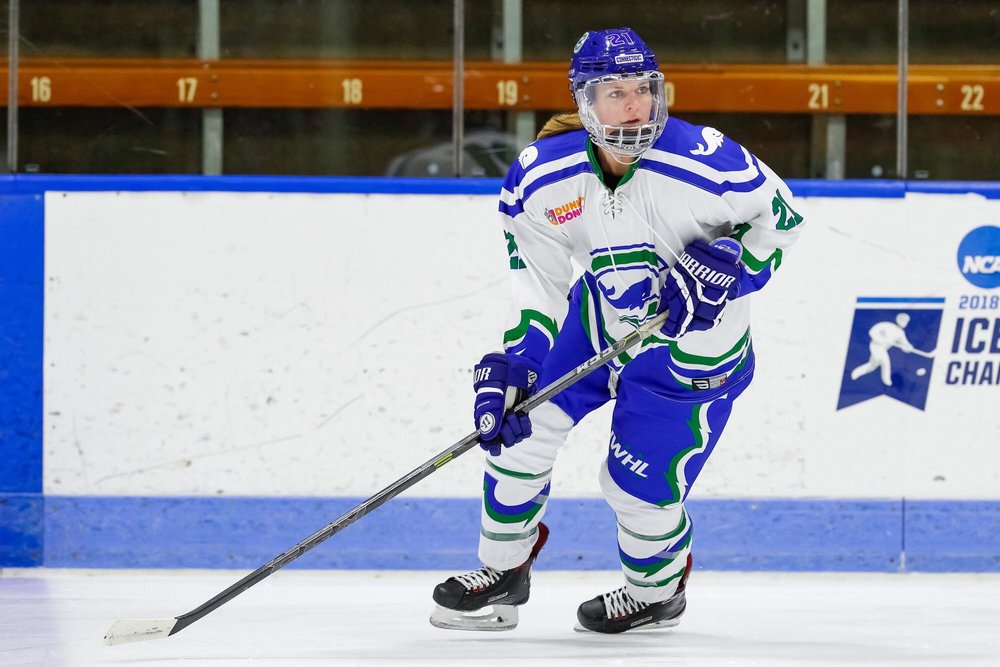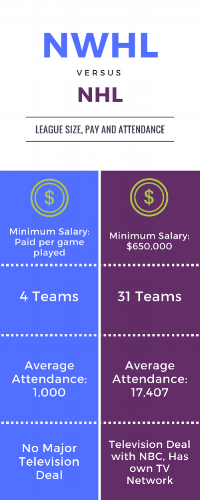
The Connecticut Whale celebrating a goal (credit: Michael Hertzel)
By Sam Prevot
Cydney Roesler first stepped on the ice when she was 5 years old.
Her father was a former college hockey player for Colgate University and taught her how to skate along with her mother. This is normal for a kid growing up in Canada, where ice sports are a way of life. At 8 years old, she made the switch from a Canadian sport called ringette to hockey. She immediately fell in love with the game. Even at a young age, Roesler was competitive and this fast, physical game was a perfect match. However, there was one catch: Roesler had to play with boys.
“There weren’t any good, competitive girls’ leagues at that time so I felt like boys hockey was my only option,” Roesler said. “People would always ask me, ‘Did the boys try to hit you all the time?’ and to be honest some of them did.”
For Roesler and so many other girls, the opportunity to watch their role models only came once every four years.
“For me it was tough growing up because I wasn’t really exposed to female hockey players … it was really just every four years,” she said. “You watched the Olympics and that was kind of it.”

Roesler on the ice for the Connecticut Whale of the NWHL (credit: Rob Rasmussen)
Roesler started playing girls hockey in high school and then played for the Quinnipiac University women’s ice hockey team.
Since the passing of Title IX, opportunities for women in sports have increased dramatically. However, there is still a long way to go when it comes to professional women’s sports. In professional women’s sports leagues are much smaller, teams struggle to put fans in seats and media coverage is lacking.
Women’s hockey has progressed since Roesler’s childhood. The Canadian Women’s Hockey League was founded in 2007 and the National Women’s Hockey League was founded in 2015, during Roesler’s junior year at Quinnipiac. She now plays for the NWHL’s Connecticut Whale.

The NWHL is just three seasons old. The league’s only broadcasting deal is with Twitter, to stream a “Game of the Week”, and three out of the four teams are still league-owned.
Attendance was high in the inaugural season, with an average of 1,000 people attending each game. Now, that average is closer to 750 people. Salaries are also an issue for the league, some players have been downgraded from a set salary to now receiving payments for each game they play. Most players have other full time jobs in addition to playing NWHL games on the weekends.
The Women’s National Basketball Association is a more established league, but it faces similar questions about attendance and salaries.
The WNBA celebrated its 20th anniversary in 2017. The league has a television deal with ESPN and a few of its teams have partnerships with their NBA counterparts. Average attendance continued to decline, but resurged and reached its highest levels since 2011 last season.
Sylvia Fowles of the Minnesota Lynx won the WNBA regular season and finals MVP in 2017, and was paid a salary of $109,000. The NBA minimum salary is more than $562,000.
Amber Cox, vice president of the WNBA’s Connecticut Sun, sees the league as a growing business that needs more commitment from fans.
“There’s a patience involved when it comes to building a fan base. In this day and age you can survive and be a growing sport,” Cox said.
“I think sometimes the miss is with fans, they’re sort of casual about it. When I’m talking to potential season ticket holders, you think you’re supporting us by coming to three games and watching us on TV and reading about us in the paper, but the way that we are going to continue to have financial success and grow this thing … is by full season tickets … Take that commitment up. If you say that to people, typically the light will go on.”
There is a disconnect in our society when it comes to men’s and women’s sports. The widely held belief is that a men’s professional sport will be of higher quality and entertainment value than women’s.
Quinnipiac sociology professor Devon Gross who teaches “Sociology of Sport” says that looking at women’s and men’s sports differently is a learned behavior based on gender constructs and the way we socialize.

“We’ve always associated masculinity and sports together,” she said. “We think of sports as aggressive and violent and competitive and those are all things we associate with men more than women. We’ve been socialized and told constantly that sports and men go together. So when women are playing sports we don’t really know how to react to that.”
There is a cultural belief that women are not as good at sports as men, and to watch women’s sports is to “settle.” There is also the comparison of women to men and the idea that female athletes are less feminine because they play sports.
“Anyone who is associated with that we automatically think of as having masculine traits. That’s where there’s the stereotype that women athletes are lesbians or that they’re more masculine,” Gross said. “There seems to be a pretty strict binary in sports and you’re either doing girls sports or boys sports and if you cross the line in any way we’re pretty uncomfortable about it.”
There is also the issue of sexualization of female athletes. Scholars say that the way male and female athletes are represented in the media is designed to “uphold sport as a male preserve” and there is still embedded sexism.
Cydney Roesler believes games like the gold medal finals between the United States and Canada’s women’s hockey teams in the Winter Olympics prove that the sport can be exciting and draw audiences.
“There shouldn’t be that disconnect between the two (men’s and women’s hockey),” she said. “Even games in our league, it gets pretty fired up. It gets physical and everything like that. It’s kind of like ‘Hey, here are the aspects the men’s game has that we’re bringing to ours too,’ why aren’t people more drawn to it? A lot of people watch hockey because they think it’s so tough with the fighting and the hits. We’re not going to fight … but we’re still physical, we’re fast, we’re skilled.”
The University of Minnesota is home to the Tucker Center for Research on Girls and Women in Sport. In an article titled Playing but Losing: Women’s Sports after Title IX, Tucker Center researchers discuss the inequalities between men’s and women’s sports that still exist today after laws like Title IX were passed.
One particular issue mentioned is media coverage of women’s sports. Although broadcast coverage of women’s sports has increased and improved in quality, this change has not translated to newspapers, magazines or televised news and highlight shows.
The article cites a 2010 study by the University of Southern California that found that ESPN aired 100 segments and over three hours for the men’s NCAA basketball tournament, and 11 segments and just six and a half minutes for the women’s tournament. That coverage of the women’s tournament was mostly a scrolling ticker at the bottom of the screen.
The Hartford Courant covers the Connecticut Sun’s home games, and some away games depending on how the team’s season is going. Jeff Smith, deputy sports editor at the Courant, says that the paper’s coverage is all about which teams are successful.
“Like any other industry that’s trying to find its way through financial challenges, we have to make choices,” Smith said. “So we can’t cover everything … when the team (Connecticut Sun) was not so good, we had to make choices and spread our resources. We would always have Sun coverage in the paper but not always with a reporter. But then last year, when the team did better … clearly that shifts the way we cover them.”
When Sports Editor Sean Barker started at the New Haven Register in 2000, there were 28 sports writers on staff. Now among three of the papers owned by Hearst in the area, there are six.
Barker believes in fair coverage for men’s and women’s sports. But he admits that traditional beliefs from older journalists and a small staff can affect coverage of women’s sports. The Register’s Connecticut Whale coverage consists of one feature per season.
“Women’s sports have come a long way in media coverage, but there is still a fight for media space. I get challenged by this every day,” Barker said. “There’s some arguments that there’s more media coverage on a television level that leads to people wanting to know more about men’s sports. Then there’s the basic argument that honestly people don’t give women’s sports the respect that they deserve.”
When it comes to these coverage choices, Barker points out that the media could sometimes create more readership for the sport instead of the sport dictating the coverage.
“Does attendance rise because there’s more media coverage, or do you get more media coverage because your attendance is higher? It’s an interesting dynamic. So if we covered the National Women’s Hockey League on a consistent basis, how would that affect attendance? It would probably go up.”
For the Connecticut Sun, Cox thinks the team should take matters into their own hands and help bring attention to the sport and the players.
“There is always more opportunity (for media coverage),” Cox said. “One of the things I tell my team all the time is that we have to continue to be responsible for telling our own story. If LeBron tweets something about something political or the type of cereal he likes, everybody retweets it and the media picks it up and they talk about it. We don’t necessarily have that critical mass on a national level.”
At the end of the day, Roesler and Cox are both optimistic about the future of women’s hockey and basketball. Rising attendance, increased coverage and social media presence are all creating a loyal fanbase for the NWHL and WNBA to build a foundation on and young girls have more role models to look up to.
“You’re just now getting to the point where WNBA players grew up watching the WNBA,” Cox said. “That is creating a cycle of ‘I know I can do this for a living, I can earn a living playing in the WNBA’ and as a result are training for it.”
Roesler recognizes loyal fans at games and at the team’s postgame signings. She sees that as a sign that the future is bright for the sport.
“There’s definitely that fan loyalty,” she said. “And you start to see the same little girls coming to the games … so you see new faces but then again you see those returners who just love to be there. For little girls now they can come watch us and dream and hope they’ll be where we are.”